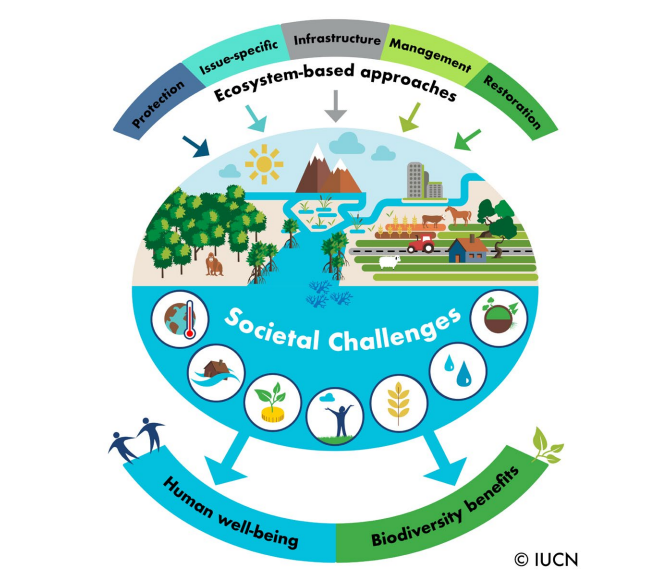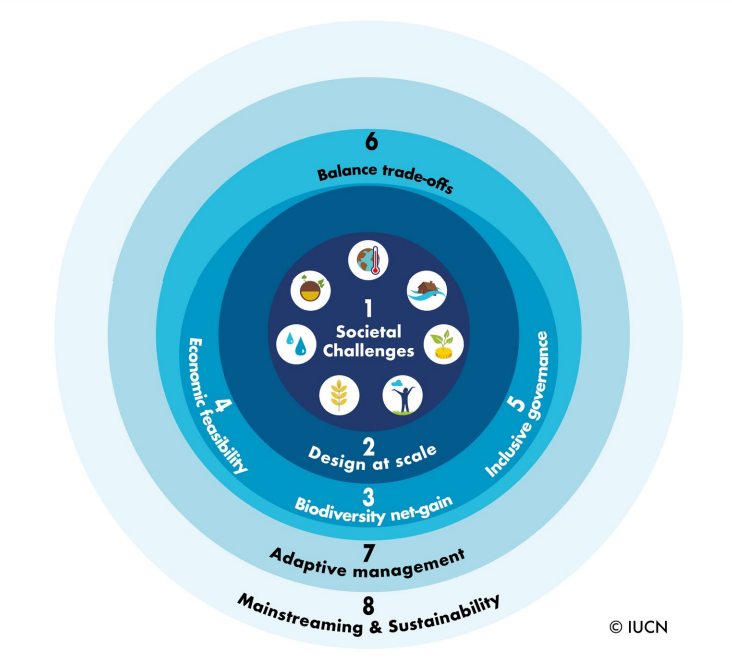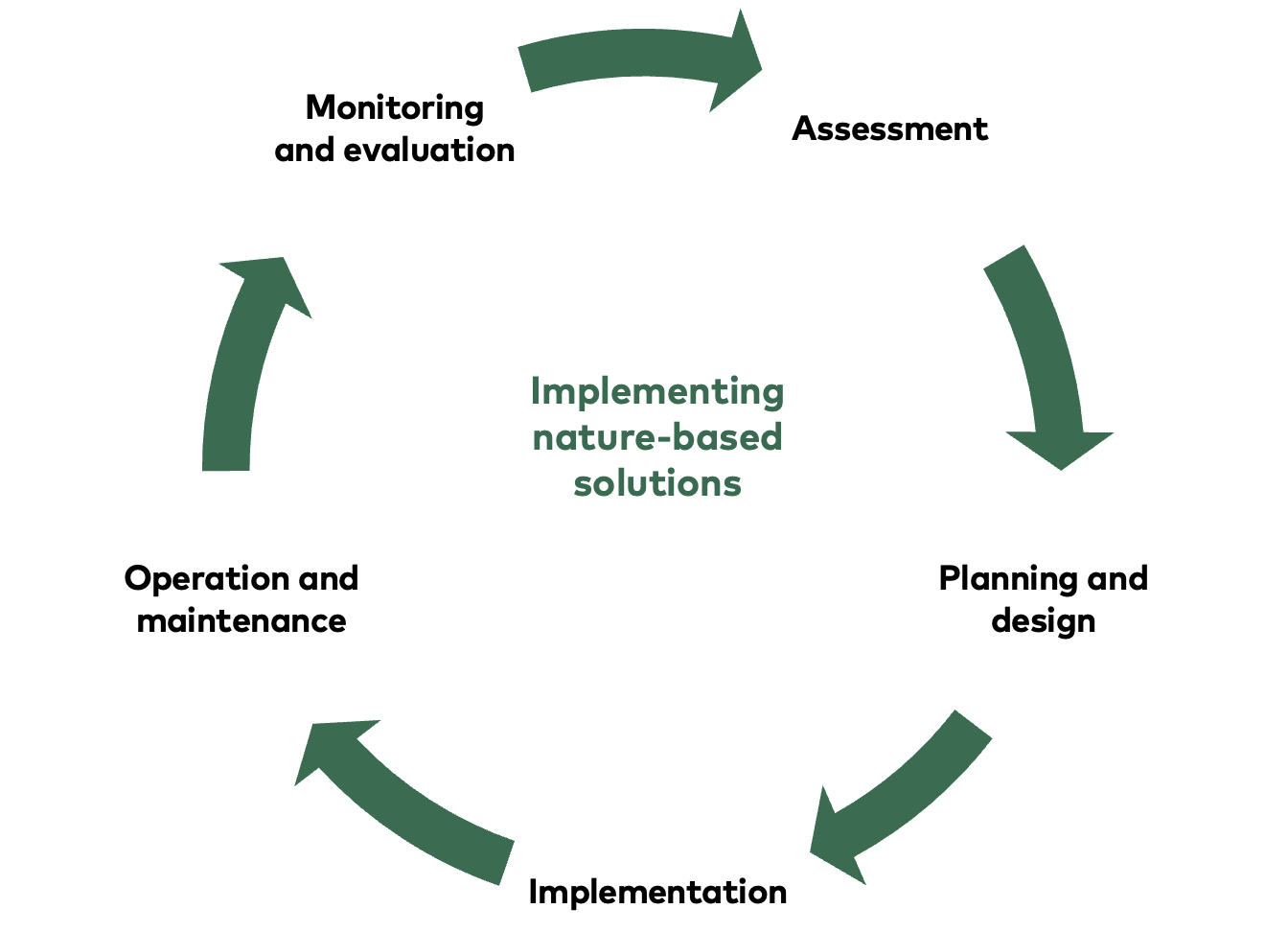2. Background on nature-based solutions
In this chapter we give a brief background on the concept of Nature-based solutions (NBS), the IUCN Global Framework for NBS and summarise the typical phases of an NBS project.
2.1 How is the nature-based solution concept defined?
There are different definitions of the nature-based solutions (NBS) concept, but the now most frequently used, and often referred to in the scientific literature, is the definition adopted by the United Nations Environment Assembly (UNEA) of the United Nations Environment Programme (UNEP) on 2 March 2022.
UNEA in 2022 adopted the first globally agreed on definition of NBS as “actions to protect, conserve, restore, sustainably use and manage natural or modified terrestrial, freshwater, coastal and marine ecosystems which address social, economic and environmental challenges effectively and adaptively, while simultaneously providing human wellbeing, ecosystem services, resilience and biodiversity benefits.”

Figure 1. IUCN defines NBS as “actions to protect, sustainably manage and restore natural and modified ecosystems in ways that address societal challenges effectively and adaptively, to provide both human well-being and biodiversity benefits” (source: IUCN, 2020; Cohen-Shacham et al., 2016).
The UNEA definition builds on the earlier definition from the European Commission (European Commission, 2015) in 2015 and the IUCN in 2016 (Cohen-Shacham et al., 2016) (Figure 1). While IUCN and UN to a larger degree emphasize conservation and protection, sustainable management and restoration of existing natural and modified ecosystems, the EU includes solutions that are “inspired, supported by or copied from nature” including constructed solutions like green walls and roofs (Sandin et al., 2022).
Even though the various definitions of nature-based solutions have some differences, they all have in common that NBS work with nature, for nature and for humans (Sandin et al., 2022). They are solutions that protect, sustainably manage, use or restore ecosystems to solve societal challenges.
Nature-based solutions are highlighted by both the IPBES and IPCC as a cost-effective way of meeting the Sustainable Development Goals (SDGs) and they play an essential role in the overall global effort to achieve these. According to UNEP (2022), NBS are “effectively and efficiently addressing major social, economic and environmental challenges, such as biodiversity loss, climate change, land degradation, desertification, food security, disaster risks, urban development, water availability, poverty eradication, inequality and unemployment, as well as social development, sustainable economic development, human health and a broad range of ecosystem services”.
At the same time, there is a substantial body of evidence, scientific literature and practitioner experience that there are challenges when it comes to implementing NBS. These include issues such as participation and equity, economic valuation, scale and time effects, integration with existing infrastructure plus governance and policy issues (Nelson, Bledsoe, Ferreira, & Nibbelink, 2020).
2.2 The IUCN Global Standard for Nature-based Solutions
The IUCN global standard for NBS (IUCN, 2020) was developed to guide the work on NBS by clarifying the concept and what is needed to ensure successful implementation (Figure 2). The standard aims to equip the users with a robust framework for the planning and design of NBS, to ensure that implementation helps to solve some societal challenge(s) and to assess outcomes and success of NBS after implementation. The standard is a step towards mainstreaming nature-based approaches in policy and practice worldwide. It aims to ensure that NBS are effective, scalable, and sustainable. Such a framework is essential to increase the scale and impact of the NBS approach, prevent unanticipated negative outcomes or misuse, and to help funding agencies, policymakers and other stakeholders assess the effectiveness of interventions (Sandin et al., 2022; IUCN, 2020).

Figure 2. The IUCN global framework (source: IUCN, 2020).
The standard encompasses eight criteria and associated indicators that focus on biodiversity conservation, ecosystem integrity, and societal benefits. These criteria aim to ensure that NBS deliver benefits for both nature and people, address societal challenges effectively, are economically viable, and are governed by inclusive and equitable processes. These criteria are:
Criterion 1 | NBS effectively address societal challenges i.e., the selection process of NBS is according to the societal challenges they are meant to address and includes their benchmarking and periodic assessment. |
Criterion 2 | The design of NBS is informed by scale i.e., the design of the NBS takes synergies and interactions beyond the intervention site into account. |
Criterion 3 | NBS result in a net gain to biodiversity and ecosystem integrity i.e., these gains need to be clearly defined and measurable. |
Criterion 4 | NBS are economically viable i.e., the economic viability of the NBS is evaluated in terms of the multiple benefits they can bring in comparison to alternative solutions. |
Criterion 5 | NBS are based on inclusive, transparent and empowering governance processes i.e., inclusive, transparent and empowering governance processes are integral to the planning, design, implementation and operational phases of the NBS and include the identification of all intended and unintended consequences, for all affected stakeholder groups and with the aim to “leave no one behind”. |
Criterion 6 | NBS equitably balance trade-offs between the achievement of their primary goal(s) and the continued provision of multiple benefits i.e., the equitable balance between the trade-offs that arise from the multiple benefits of an NBS interventions to different stakeholder groups is maintained and, if needed, corrective actions to balance these benefits are implemented. |
Criterion 7 | NBS are managed adaptively, based on evidence i.e., adaptive management of the NBS is based on evidence gained by regular monitoring of the intervention throughout its lifecycle. |
Criterion 8 | NBS are mainstreamed within an appropriate jurisdictional context i.e., the implementation of NBS should be embedded in the appropriate jurisdictional context and trigger transformative change towards sustainability. |
In their global standard, IUCN (2020) has also defined several indicators to assess the level of achievement of these eight criteria. Moreover, they developed a self-assessment tool in Excel, that can be used to evaluate the implementation of NBS (see Appendix 3).
2.3 Nature-based solutions project phases
Going from an idea to actual implementation of any intervention or project can broadly be divided into different phases: before, during and after. The same is true for nature-based solutions (NBS). It is important to note that this report is not about NBS themselves, but rather NBS (related) projects. This distinction is relevant for several reasons. First, it has to do with scope and specificity; NBS as a concept is broad, and it encompasses a wide range of approaches for using nature to address different societal challenges, both in practise and in the planning processes. In contrast, NBS-related projects are specific implementations such as restoration actions. It is important to also keep in mind, in line with the UNEA NBS definition, that NBS also includes the actions to protect and conserve already intact nature with its ecosystem functions, e.g. through spatial planning. If these functions are damaged or gone, actions can be taken to restore and repair or reconstruct nature and its processes.
By focusing on NBS projects, one can provide concrete examples of how NBS principles are applied in practice, offering context-specific, detailed insights. It concerns the practical application and allows for a deeper understanding of how NBS concepts are translated into action. It highlights the practical aspects, including challenges and successes grounded in real-world situations. By examining projects, one can explore the entire lifecycle of NBS implementation – from the initial assessment, planning and design (before), through the execution and active management phases (during), to the post-implementation phase, where outcomes are monitored and evaluated (after). Such a lifecycle perspective is essential for understanding the effectiveness, sustainability, and scalability of NBS interventions. Focusing on NBS-related projects facilitates a discussion about adaptive management and iterative learning. It allows for assessing how projects evolve over time, how they respond to unforeseen challenges, and how lessons learned can inform future NBS initiatives. Analysing specific projects can provide valuable insights for policymakers and funders, as it can illustrate the types of support and resources necessary for successful NBS projects, as well as the potential barriers that need to be addressed.
The phases that go into the actual implementation of an NBS are typically (see Figure 3):
1) Assessment 2) Planning and design, 3) implementation, 4) Operation, maintenance, and ongoing management 5) Monitoring, evaluation and reporting. These can also be considered components rather than phases, as they might overlap in time and activities and be iterations within one project. Each component, however, could be seen as having its own distinct focus and key activities.

Figure 3. Phases/components of NBS projects. Inspired by FAO, SER & IUCN/CEM (2023).
This report does not include a full cycle analysis of the pilot projects as the projects were still ongoing and not yet completed when finalising this study. However, insights have been captured from the first phases.
During the study period, the pilots offered diverse insights; some focused especially on preparations and planning, while others engaged already in practical, on-the-ground implementation. In essence, while NBS as a concept provides the theoretical foundation, the focus on NBS-related projects offers a pragmatic view of how the concepts are operationalised, their real-world impacts, and the lessons learned from their implementation.